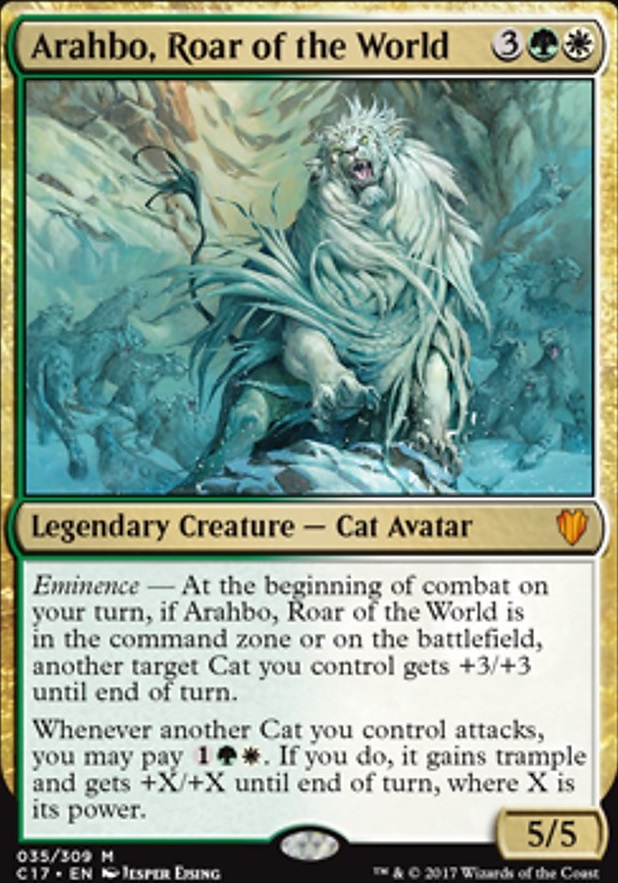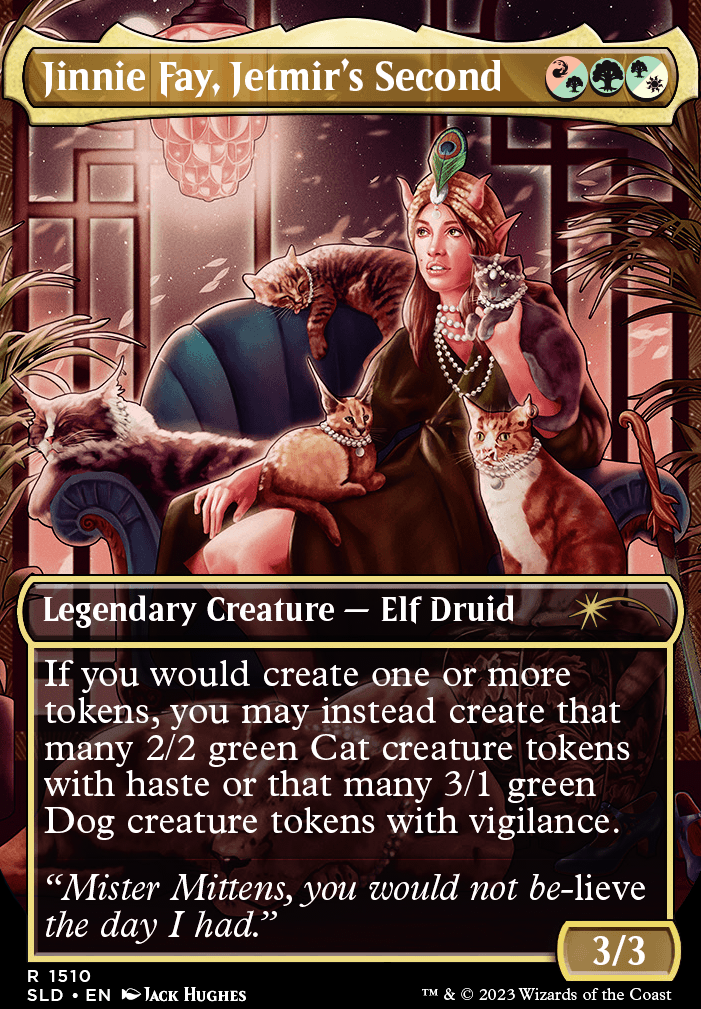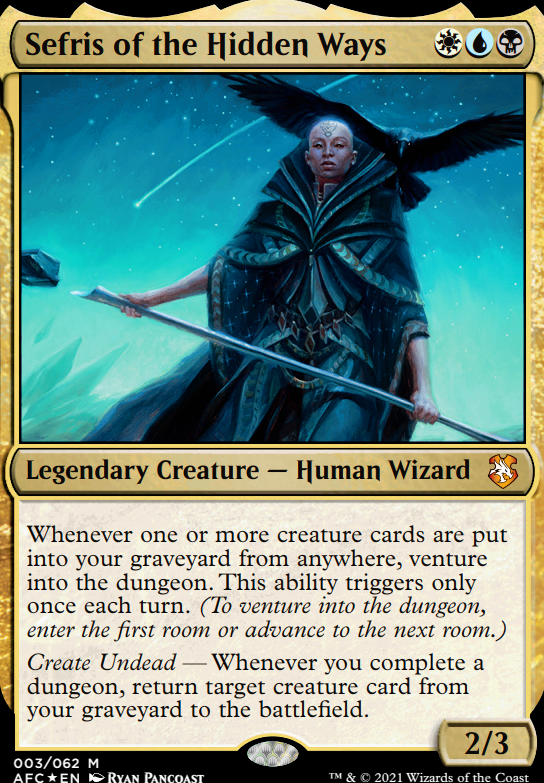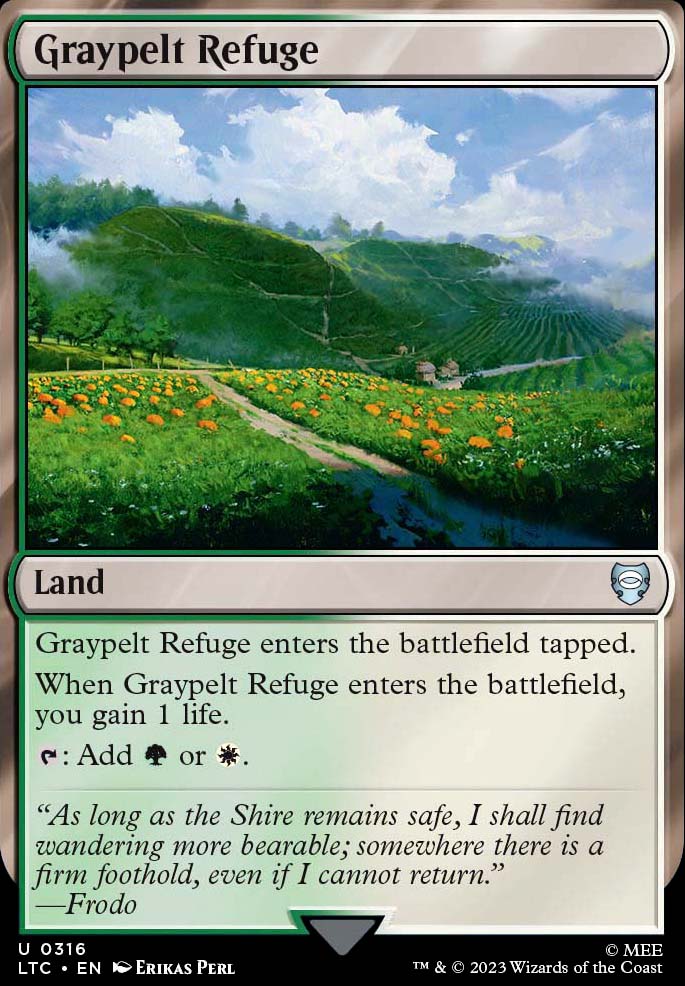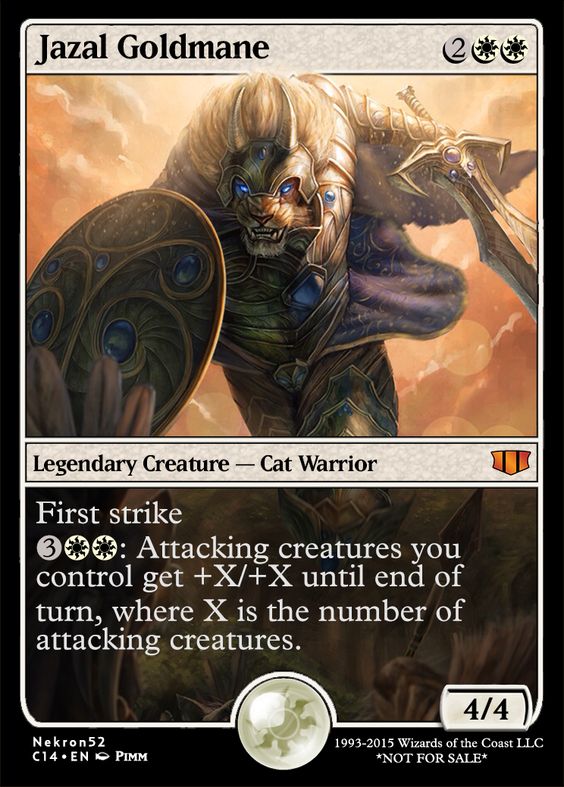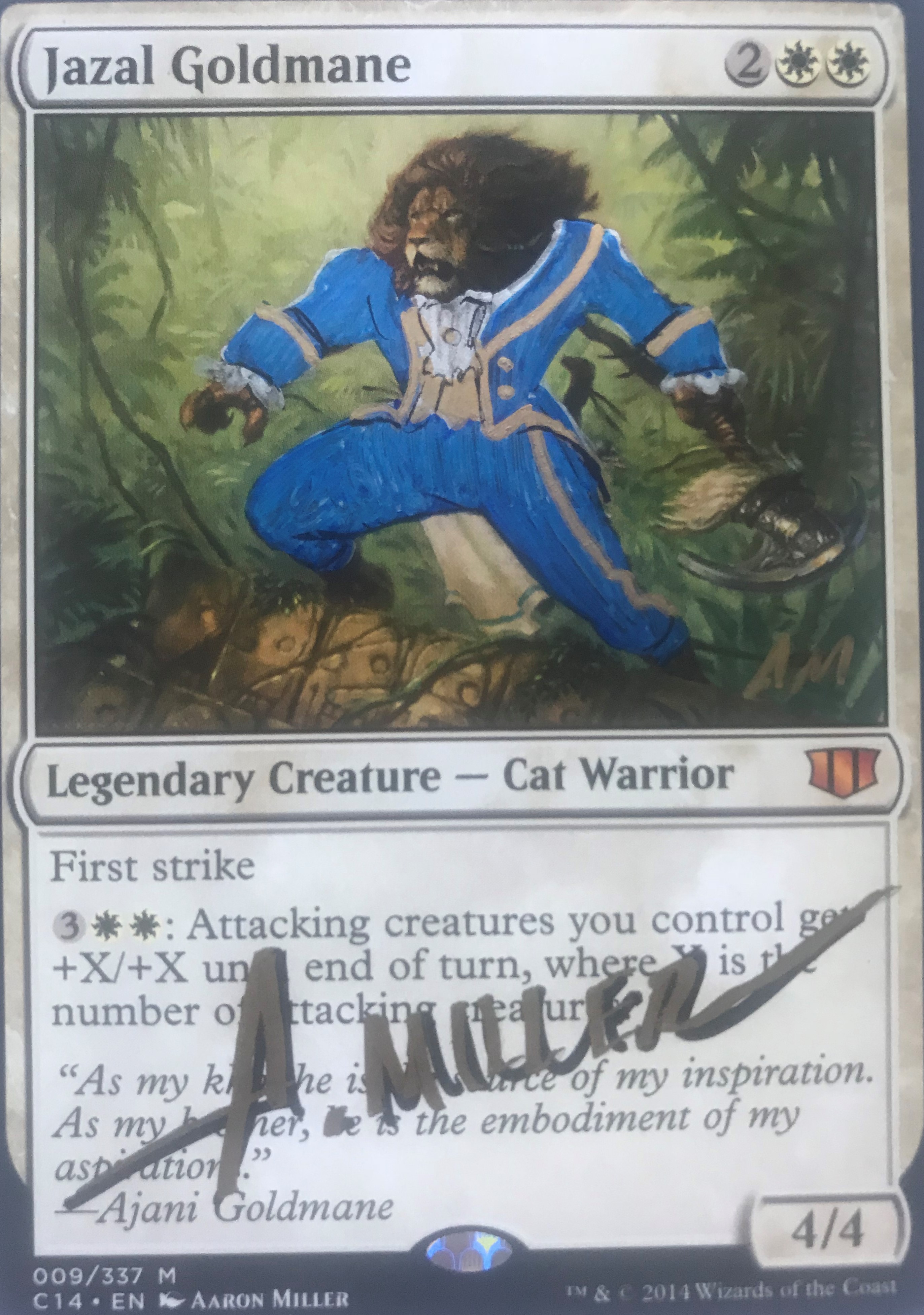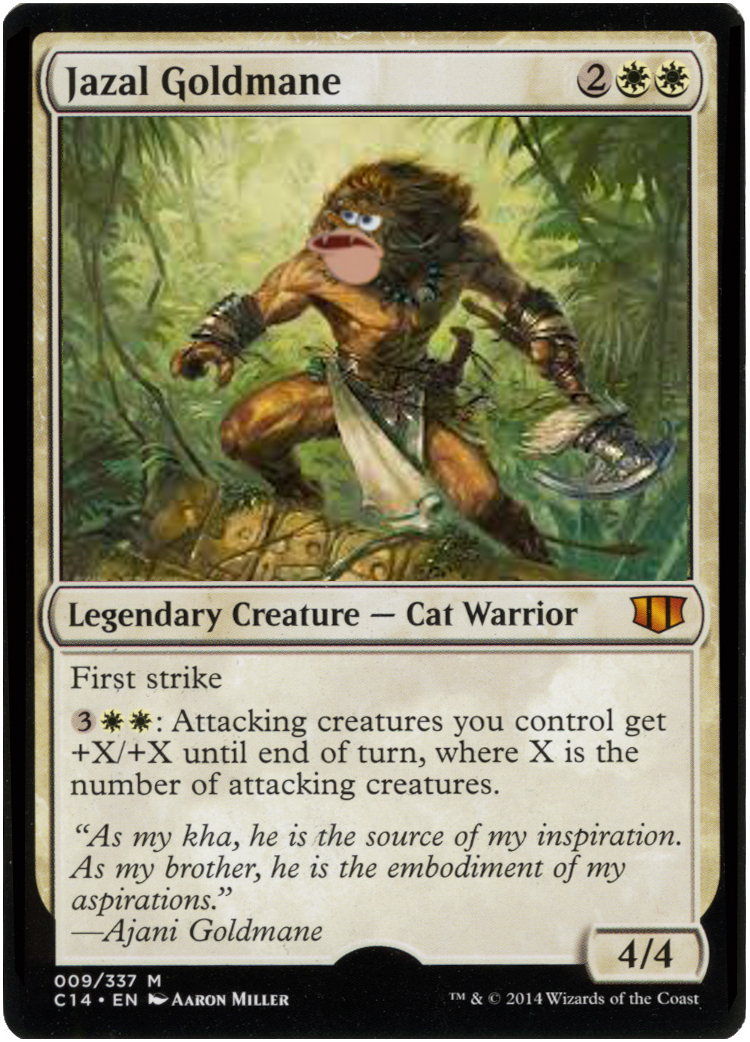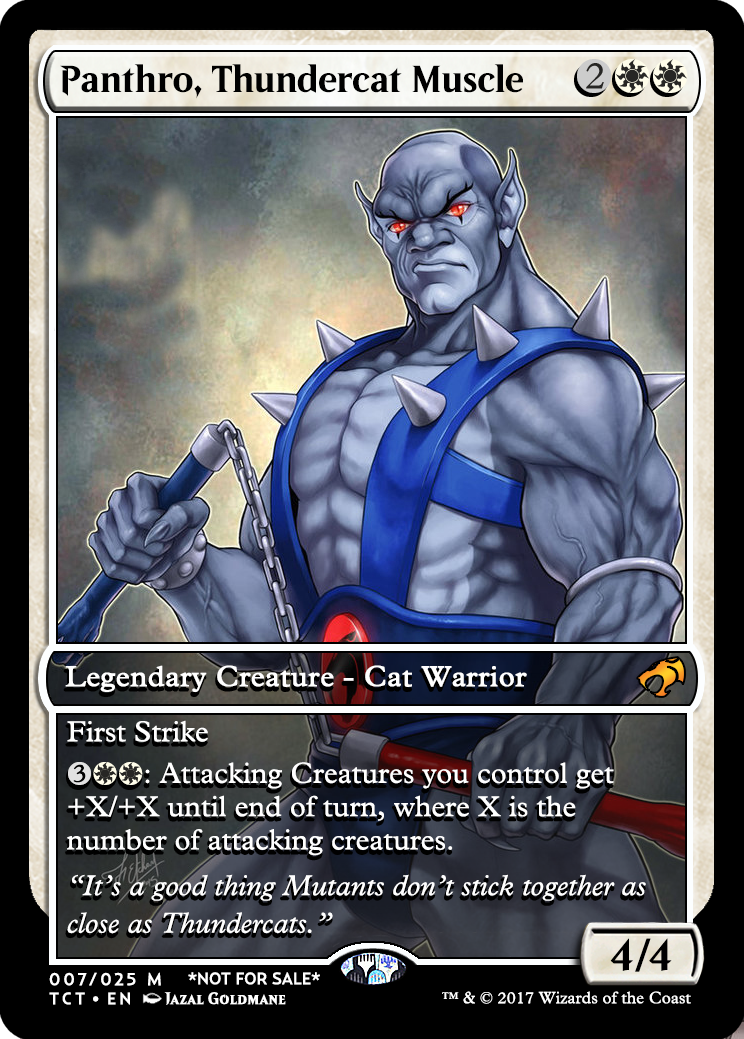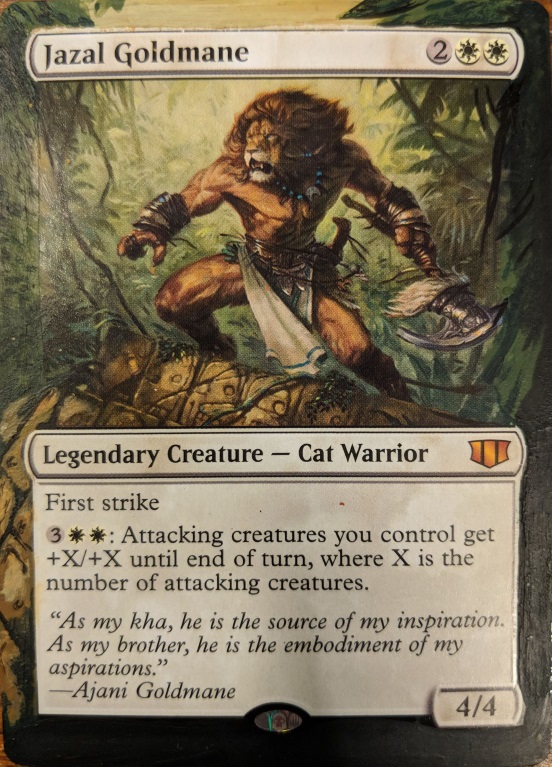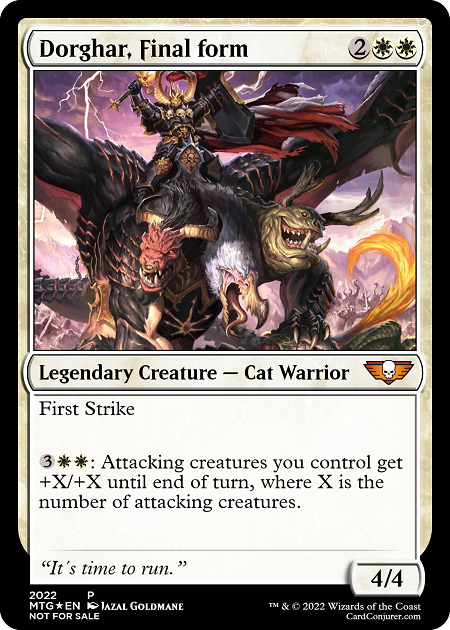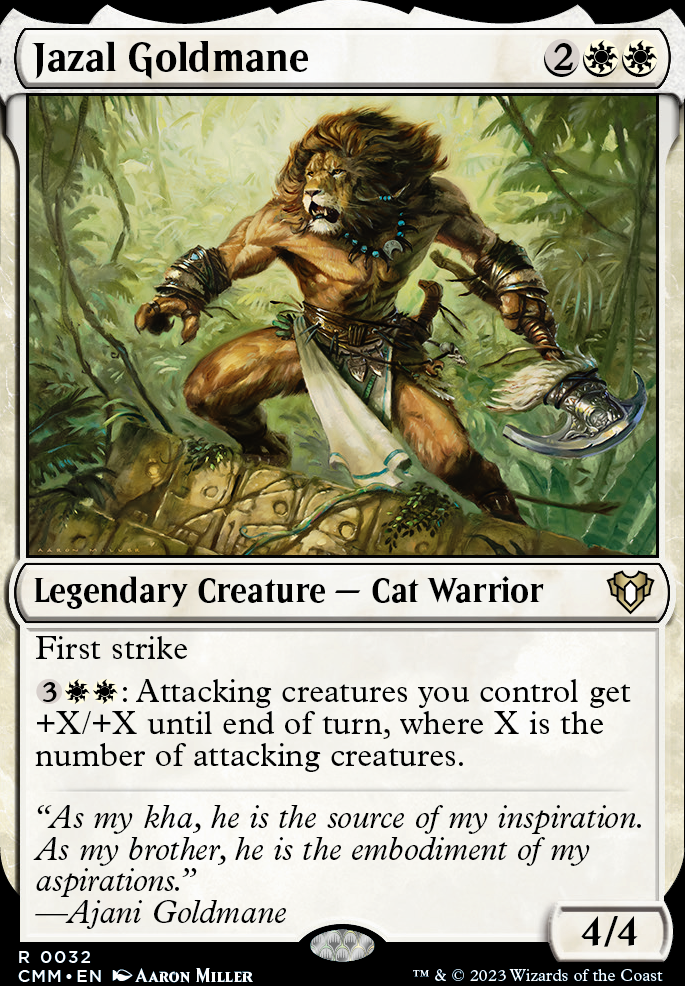
Combos Browse all Suggest
Legality
| Format | Legality |
| 1v1 Commander | Legal |
| Alchemy | Legal |
| Archenemy | Legal |
| Arena | Legal |
| Canadian Highlander | Legal |
| Casual | Legal |
| Commander / EDH | Legal |
| Commander: Rule 0 | Legal |
| Custom | Legal |
| Duel Commander | Legal |
| Gladiator | Legal |
| Highlander | Legal |
| Historic | Legal |
| Legacy | Legal |
| Leviathan | Legal |
| Limited | Legal |
| Oathbreaker | Legal |
| Planechase | Legal |
| Quest Magic | Legal |
| Vanguard | Legal |
| Vintage | Legal |
Jazal Goldmane
Legendary Creature — Cat Warrior
First Strike
: Attacking creatures you control get +X/+X until end of turn, where X is the number of attacking creatures
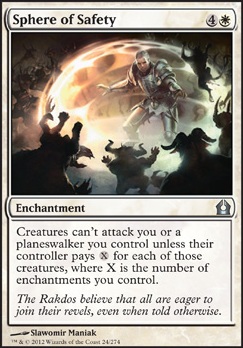
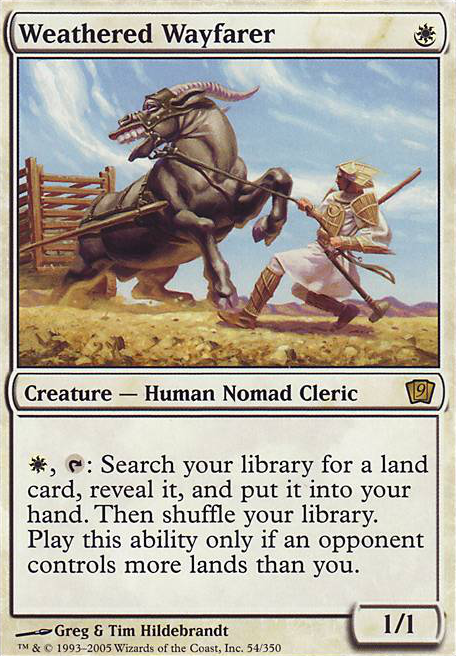
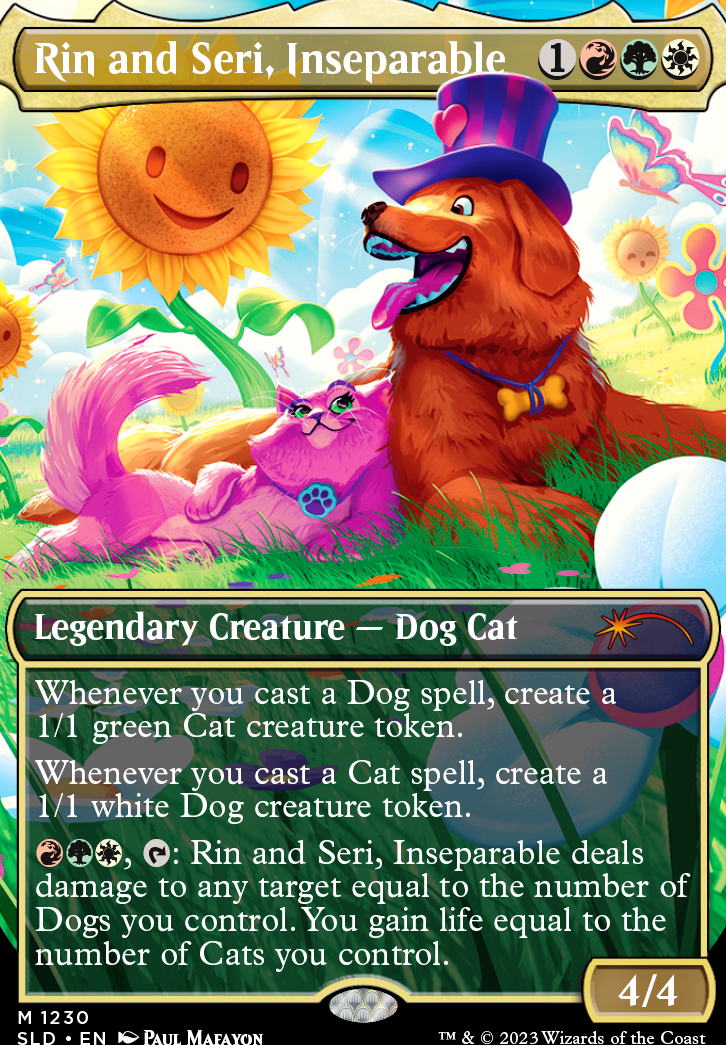
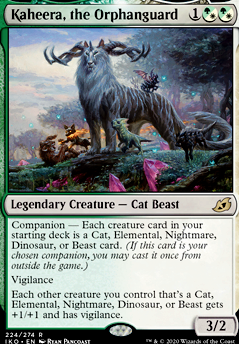
Last_Laugh on
 Odric's Keyword'ed Soldiers
Odric's Keyword'ed Soldiers
3 months ago
Everything Comes to Dust is a new tribal boardwipe I've had good success with.
Mirror Entity is excellent is any go-wide token strategy and he's technically a soldier.
Reconnaissance allows you to attack with everyone safely, deal damage in most situations, and have every one of those creatures untapped by the end of combat (ignore the 20+ year old reminder text, it's misleading).
I have a non-white deck with Jazal Goldmane at the helm. Feel free to check it out for any other ideas (like Crackdown). Upvotes on any of my decks are appreciated. Goldmane... The Other Brother
Last_Laugh on
 Big Darien's Soldier Machine
Big Darien's Soldier Machine
1 year ago
Oh, and on the note of Jazal Goldmane, he deserves a spot too.
KBK7101 on Commander Masters Previews and Speculation
1 year ago
I feel like I say this every time there is a big reprint set, but... Parallel Lives and/or Anointed Procession reprints, please!
I also kind of hope that Jazal Goldmane gets a reprint solely for the fact that none of his current printings come in foil. My inner vorthos needs a foil one, dammit!
Last_Laugh on Basics matter theme - Mono …
1 year ago
Armored Ascension cares about your Plains count and turns pretty much anything into a threat. I'd personally suggest going wide with mono white rather than voltron. It opens up some cheap but very effective wincons like Mirror Entity, Jazal Goldmane, and Felidar Retreat.
Guerric on Deck Archetypes in EDH
1 year ago
Hi all! There's an interesting question I've been pondering lately, and I thought I'd share some of my reflections on it and get input from all of you. In sixty card magic we have deck archetypes, namely aggro, control, midrange, combo, and tempo. In commander obviously things look pretty different, and several years ago on the Command Zone podcast they said that like in limited, there aren't really deck archetypes this way, just different flavors of midrange.
As the format has developed and changed a lot over the years I do think something like these archetypes exists in commander, they're just different. For those familiar with sixty card formats some of the hard and fast rules for those archetypes in sixty card magic do not apply, and there certainly is more fluidity on commander and other unique multiplayer strategies as well (ex. Group Hug). Nonetheless, I think the outline of most of these archetypes is still relevant. Here is how I think it plays out-
1) Aggro- I think something more like classic aggro has only become viable in commander in the past couple of years, but I think it is definitely a thing now. In sixty card magic, most creatures are in the one to three drop range, there is often no focus on card draw, and everything in the deck serves to get a single player to zero as quickly as possible. Obviously in commander we need raw engines, some ramp, and are going to play more powerful cards. That being said, I think strategies built around attacking with high value, low cmc creatures from the early game onwards characterizes aggro in commander. This wasn't viable a few years ago due to the lack of board state protection, and really only token pump decks and creature cheat decks tended to do well. But the printing of many premium white board state protection spells like Flawless Maneuver, Teferi's Protection, and Semester's End has changed up the formula a bit. Attacking low to the ground and early is a keystone of aggro strategies, but so are on attack triggers. We have so many of these now, and they incentivize keeping our force swinging every turn. Commanders like Akiri, Fearless Voyager and Trynn, Champion of Freedom incentivize attacking in order to draw cards, make tokens, or do other things the deck is going to want to do. Unlike sixty card magic, we will need to be able to draw cards, and play some removal and interaction, though we'll play fewer pieces of the latter here than in other decks since they compete with resources to keep up the attack. We also need to play one-sided board wipes wherever we have the option, because we can't afford to lose our own board state. We'll also need a way to get through for damage once our opponents' defenses are up, and as such things that give our creatures menace, landwalk, flying, deathtouch or indestructible are key as they help us keep up the assault. We're also very in favor of a few key pump spells to help us finish out the game like Jazal Goldmane or Coat of Arms.
2) Midrange- In sixty card magic midrange is characterized by playing some of the most powerful cards on every point in the curve, and play more removal than aggro decks. Oftentimes they are characterized as "the growing threat." A classic and famous example was the classic Modern Jund deck that Reid Duke piloted several years ago. One of its touchstones was playing Tarmogoyf on turn 2. The goyfs could attack or block where necessary, but they would grow more unstoppable as the game went on, until they were dropping haymakers like Liliana of the Veil. They would use cards like Dark Confidant to keep their hand full till they could inevitably win. In a way, these sorts of decks mirror something of what we see in all commander decks in that they play removal, draw, and powerful cards. Yet what I think sets them apart is this idea of the growing threat, and that they play more removal than aggro decks. One way in which I think some midrange commanders work is to have abilities that allow them to turn other cards into Tarmogoyf like threats. Ezuri, Claw of Progress and Giada, Font of Hope use +1/+1 counters to turn small evasive threates into significant ones. In this sense, I think a lot of counter decks fit well in the midrange categories. These decks will attack, but they don't have to like aggro decks, and are more willing to conserve resources and work on developing board state where feasible. They often have engines that benefit their board passively from the passage of time, and as such they can play more removal and let their board build itself. They still want to protect their board state, and some of the cards from aggro decks that do this or simply counterspells can help with this, and one-sided board wipes are usually th best kind for midrange decks as well.
3) Control- Control decks in sixty card magic are built on trying to shut down almost everything an opponent is trying to do via counterspells and removal until you can work towards a win con. This obviously is not possible in commander where you can not shut down three other players with just counterspells and removal alone, and isn't always necessary since opponents can also shut down each other. As such, controlling strategies fit into two categories: stax and regular control. With stax pieces that shut off lands and mana rocks, eEDH controlling strategies indeed can effectively shut down three other players, usually finding a way to work through it themselves in order to build towards a win con. In standard EDH, heavy land-based stax like that is frowned upon, but cards that disrupt play in other ways (ex. Blind Obedience as well as counterspells and removal are fair game. These decks are still building towards a win con by slowing opponents down, and will devote far more slots to disruption and removal than aggro and midrange decks. They may win with an infinite combo, a planeswalker, a few premium attacking creatures, or in other ways, but most of the deck is devoted to protecting themselves and disrupting opponents. Controlling decks are more likely to play reciprocal board wipes, and generally benefit from keeping the board clear of threats at most times.
4) Combo- Combo decks also exist along a spectrum in EDH, though this archetype is most similar to sixty card magic. The formula is almost unchanged for cEDH, where most of a deck is devoted to playing and protecting a single combo. Outside of cEDH, it is worth mentioning that infinite combos can be included in almost any archetype in the format as a backup win con when other plans go sideways. What makes it a combo deck is that the entire deck is focused on pulling out one of a variety of sometimes elaborate combos, and these decks are generally geared more towards Johnnies than Spikes. A good example would be combo decks built around Teysa, Orzhov Scion that can put together the Darkest Hour in a variety of ways, as well as play Reveillark + Karmic Guide and/or Sanguine Bond + Exquisite Blood in order to win. These decks play out as trying to put together a combo while fending off opponents with removal and interaction.
5) Tempo- Some might argue that there is no such thing as tempo decks in commander, but it's worth mentioning that they're pretty rare even in sixty card magic across formats. In sixty card magic tempo decks adopt a "disruptive aggro" philosophy, where they slowly chip away at an opponent's life total with small, cheap, evasive creatures, while always holding mana open to protect their board and disrupt threats. While "chipping away" life totals isn't much of a strategy in a multiplayer strategy, I do think there are decks that play out along the lines of this disruptive aggro strategy. As an example, Ranar the Ever-Watchful and Alela, Artful Provocateur can be played this way, where the flying tokens they generate are the main win con, and the rest of the deck is devoted to holding mana open to protect this main game plan and stop others from winning. Unlike in sixty card decks these may win all at once with token pump effects or other affects, but this is the main way.
What do you all think? Do you think there are deck archetypes like this in EDH? Why or why not? What qualifications would you add or take away about them if you do?
Guerric on Dealing with politics as an …
1 year ago
Hi Dazard! What a great question! I avoided aggro strategies for awhile for this reason, but as my sneaky combo strategies are hard for some groups I play with to decode, I decided to make some good old honest aggro decks, and I think I've figured out a good balance.
To begin with, don't play like in a 60 card, 1v1 format. In those games you have little incentive not to go for broke all the time, and to commit all of your resources right away. In EDH there are several key principles of good aggro play.
One of them is controlled growth. Even if you can commit all of your resources to powerful plays early you shouldn't do so. You need to make sure that you set up card draw engines and other things to keep your tank full in the long run. You should be attacking, but keep in mind you don't need to attack with everything. Chip away at peoples' life totals rather than hitting one person hard. Once you slam one person you will be the archenemy of all, so don't do that till you are a turn or two from winning or they will destroy you. Knocking out an opponent early doesn't necessarily help as that person is a target for someone else and can help keep someone else under control.
A second principle is try to win all at once via pump effects. Its almost better to keep your tokens as 1/1s as long as possible and then suddenly in a single turn make them gamewinning with Coat of Arms, Shared Animosity, Jazal Goldmane, or Mirror Entity. Don't play these cards early either! Your opponents will just kill them, so play them the turn that you can win. Surprise is one of the most powerful things in EDH. If they know you can kill them you are a threat, if they don't see it coming you will win.
Thirdly is politics via threat assessment, not deals. Sometimes people just think of politics as bribery, but its better to simply point out what other opponents are doing. "Hmm..he just played Ashnod's Altar. That's a combo piece. What's he up to?" is far more powerful than promising not to attack someone. This is self-interested, but it is also helping your opponents play better by noticing more than obvious threats. When I play against aggro I might have a board wipe, and yet hold off if I'm not afraid of imminently dying to let the aggro player do some of my dirty work for me and keep attention away from the combo I am putting together. My one friend who has been quite good at aggro has become adept at pointing out what I am doing and keeping things honest. It's also a good idea with early attacks to take turns attacking different opponents for only a small amount of damage, or even rolling the dice to see who you'll attack first. If your opponents wonder why you're holding back you can just say somewhat honestly that you're trying to spread the love around and keep blockers and critical pieces in play.
A fourth principle is board state protection. Others mentioned Unbreakable Formation and Teferi's Protection as helpful cards. Don't forget also about Make a Stand, Flawless Maneuver, and Cosmic Intervention. The latter won't save your tokens, but it will save other pieces. The same is true with Eerie Interlude and Semester's End which can also dodge even a Cyclonic Rift. Lapse of Certainty can also delay a board wipe for a turn and waste your opponents' investment, and is good tech as well. Eldrazi Monument is also a good card, because you'll have endless tokens to fuel it, and all of your stuff will be flying and indestructible, keeping your opponents from easily stopping you. One final way in your deck is just by making board wipes painful, which you can do with aristocrats. Blood Artist and Syr Konrad, the Grim will make your opponent think twice about wiping the board. Again, don't commit too many resources at once, and hold up mana for protection. This helps with controlled growth and helps you rest easy during your opponents' turns.
A fifth principle that is great is to always have a backup plane for when things go wrong. One way to do this is to have a single infinite combo to win out of nowhere when things are down. When you're playing aggro opponents are always looking at your board state, but they can be taken by surprise when you combo the win. For Markov the best one is probably Exquisite Blood and Sanguine Bond. If your opponents can win with this stuff then its only fair that you can in a pinch too! This also fulfills the old idea talked about on MtgGoldfish that you should always have a way to win out of nowhere. The other and more honest way to do this is just to have a way to recover your board state. Patriarch's Bidding and Haunting Voyage can help you recover all of your creatures in a single turn. Having these backup plans will make life easier.
Don't get discouraged, aggro is better than ever in EDH today due to new board protection and recovery tech Wizards has printed and reprinted in the past couple of years. All you need to do is master the playstyle and you'll have a lot more fun and success!
FelixCarter on
 You'll be Najello after I'm done with you
You'll be Najello after I'm done with you
1 year ago
Sorry, some last minute thoughts:
Surrak Dragonclaw or Stonehoof Chieftain are great replacements for Khenra Charioteer.
Nath of the Gilt-Leaf is a good replacement for that Blaring Recruiter if you still haven't replaced it.
Kazuul, Tyrant of the Cliffs is better for a good defense. With all the creatures already giving haste (your commander being one of them), Rushblade Commander can be swapped.
Jazal Goldmane will give HUGE attacks and could replace Kargan Warleader is you're willing to dump mana on combat.
I would add Drumhunter due to it's card draw. Replace Duskwatch Recruiter Flip if you can.
Some notable mentions include: Boldwyr Intimidator, Arashin Foremost, Champion of Rhonas, Butcher of Malakir, Dragonscale General, and Flamerush Rider.
Guerric on
 Faeries
Faeries
1 year ago
Hi Switchfox! I've played Alela in brawl quite a bit, have long pondered building her in commander, and have a lot of experience with both faeries and token decks, so I think I can be of help here. I think the low cmc focus is great, especially as it will let you cast artifacts and enchantments while keeping mana open for control pieces, and I also think you are exercising good judgment in terms of your low creature count, as artifacts and enchantments will do your most work here! I also think the land count is good.
What I'd personally recommend cutting are the anthem effects like Intangible Virtue and the like. I used to play lots of these cards and found them underwhelming, and after testing in token decks I usually end up cutting almost all of them. The problem with them is that they raise your threat level incrementally, and keep your opponents' attention on you. In the meantime, they shut off great cards like Skullclamp as well as Welcoming Vampire and Mentor of the Meek, which would be good additional draw engines here. Instead, I find it far more impactful to win out of nowhere with Coat of Arms, which I can tutor out at instant speed with Whir of Invention, or Jazal Goldmane, who can be fetched with Search for Glory, or Mirror Entity, which can be grabbed with Recruiter of the Guard or any black tutor.
I am guessing you have a lot of pillow-fort elements here because they are enchantments and synergize with your theme, and you may be in a meta with a lot of aggro coming your way and don't want to always waste your tokens chump blocking. Still, I'd personally replace No Mercy with Sphere of Safety, which is the best pillow-fort card there is, and then use the money you save to pick up a strong universal tutor like Demonic Tutor, Diabolic Intent, or Grim Tutor.
Personally I'd also add Norn's Annex to replace Settle the Wreckage, which will add to your artifact count and give you another strong pillow-fort element that won't ramp your opponents and will be more permanent. I tried Settle in so many decks on account of fondness of it from when it was in standard and I never like it in EDH. You might be thinking of using Settle to ramp yourself by exiling your own tokens and that can work, but personally I found it less significantly helpful than I had hoped for.
| Have (4) | zachi , metalmagic , Va1mar , JordanSanFran |
| Want (0) |


